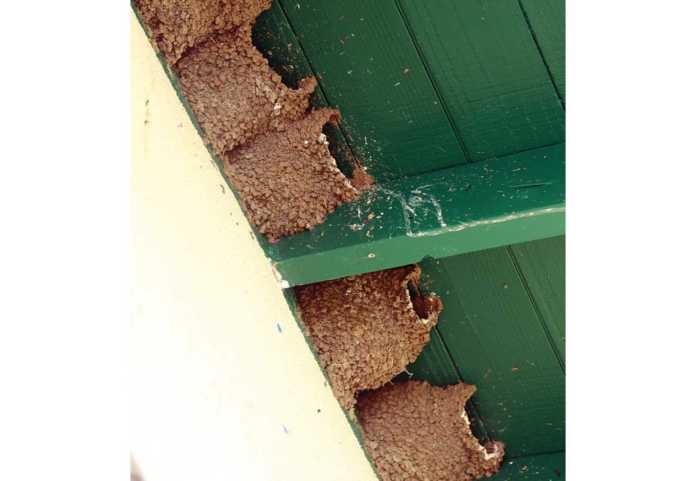(Cliff swallow nests at Pajaro Valley High School line the eaves on numerous roofs. Photo by Tarmo Hannula/Pajaronian)
WATSONVILLE — The annual return of the cliff swallows to the Watsonville area can be a treat for bird enthusiasts, who marvel at their ability to migrate from as far away as Argentina, and then cobble their nests from thousands of beakfuls of mud on cliffs and buildings.
Driven by instinct to return to the place where they were born, the birds typically build their nests on the same spot every year, often placing them in the nooks, crannies and overhangs of human-occupied structures. There, they line the inside with feathers to make a cozy nursery until their chicks fledge.
But for some, particularly those whose homes and buildings become unwitting hosts to the nests, the return can be bittersweet.
Too often, the birds’ leave behind copious droppings as they fly back and forth to feed their chicks.
The swallows build their nests in numerous places at Pajaro Valley High School, where they have easy access to nearby wetlands and the insects they depend on. They are particularly fond of mosquitos, and play a key role in keeping populations of that insect low.
But their flights take them over the school’s cafeteria and along classroom buildings. Worse, the birds dart around the outdoor eating area and leave droppings on tables, causing sanitation woes for school administrators tasked with student health and safety.
PVHS science teacher Gary Martindale said he surveyed the nesting birds in 2011 and discovered the school boasted 1,422 birds, making it the largest breeding colony of cliff swallows in Santa Cruz County.
Their choice of location was no surprise, Martindale said.
“If you build buildings that look like cliffs, cliff swallows will nest there,” he said.
But as the colony grew bigger the challenge grew bigger, Martindale said.
While the piles of poop are a pernicious problem, removing the nests poses a different challenge.
According to Martindale, cliff swallows — and a host of other birds — are protected by the Migratory Bird Treaty Act of 1918, an international agreement between the U.S. and Canada.
That law calls for a $5,000 fine for destroying a nest containing chicks or eggs. Breeding season runs from mid-February until early September.
School workers tried circumventing the rule by knocking the nests down as they were being built, confusing the birds and drawing an outcry from the people who attend and work in the school.
Aptos resident Becky Steinbruner, who is part of Friends of the Cliff Swallows at Pajaro Valley High, said her group has helped convince Pajaro Valley Unified School District to wait on removing the nests during nesting season.
The group’s advocacy was bolstered by a student letter writing campaign and advocacy by the school’s science teachers.
“There are a lot of people rooting for the birds,” Martindale said.
Efforts to lessen the bird problem began in November 2017, when the PVUSD Board of Trustees approved $53,300 to place Plexiglas sheets over the areas where the birds place their nests. While somewhat effective, that measure merely prompted them to move their nests lower.
Placing nets over the sites is no good, since it can ensnare birds, Steinbruner said.
The hope now, she said, is that the group can fund the construction of structures where the birds can build their nests away from the school.
On Saturday, long after the last baby left the nest, a group of club members and students took the remaining nests down.
It is not clear whether humans will find a way to exist in harmony with the birds. What is certain is that they will return in February, and that they will mostly be welcome.
PVHS administrative secretary Yvette Hagan, a member of Friends of the Cliff Swallows at Pajaro Valley High, said the birds and their annual 8,000-mile round-trip journey brings a “sense of hope” to the students, many of whom are migrants themselves.
“I am a big fan of the bird,” she said. “They are resilient and persistent, and I admire the fact that they have chosen this place to nest.”













